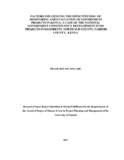Factors Influencing the Effectiveness of Monitoring and Evaluation of Government Projects in Kenya: a Case of the National Government Constituency Development Fund Projects in Dagoretti North Sub-county, Nairobi County, Kenya
Abstract
Monitoring and evaluation helps track project performance at any given time and provides reasons for an observed project status. The study sought to establish the factors influencing the effectiveness of monitoring and evaluation of government projects in Kenya: A Case of the National Government Constituency Development Fund Projects in Dagoretti North Sub-County, Kenya. The objectives of the study were to establish the influence of training levels on the effectiveness of monitoring and evaluation of Government Projects case of National Government Constituency Development Fund projects in Dagoretti North Sub-County, to determine the influence of cost of monitoring and evaluation on the effectiveness of monitoring and evaluation of Government Projects case of National Government Constituency Development Fund projects in Dagoretti North Sub-County, to assess the influence of time allocation on the effectiveness of monitoring and evaluation of Government Projects case of National Government Constituency Development Fund projects in Dagoretti North Sub-County, and to examine the influence of stakeholder Participation on the effectiveness of monitoring and evaluation of Government Projects case of National Government Constituency Development Fund projects in Dagoretti North Sub-County. Currently, there is inadequate knowledge on the factors influencing the effectiveness of monitoring and evaluation of government project a situation that this study seeks to address. It is hoped an understanding of factors influencing the effectiveness of M&E can improve the practice of M&E and consequently project performance among government institutions, students of project management and researchers in M&E. The study targets monitoring team in ongoing NGCDF projects in the Dagoretti North Sub-County. In total 2000 respondents, representing monitoring and evaluation team were targeted. The study utilized formula by Yamane (1967) to arrive at a sample size of 95 respondents. In addition 10 sub-county administrative staffs were purposively sampled to form key respondents. The sample for this research study was selected using stratified random sampling method. The main tools of data collection for this study were questionnaires. A questionnaire was used to gather primary data. Data will be collected, examined and checked for completeness and clarity. Numerical data collected using questionnaires were coded and entered and analyzed with the help of computer Statistical Package for Social Scientists (SPSS) versions 21 software programme. The data was analyzed using Correlation regression; the study used Spearson correlation to relate the variables. The study found that the coefficient of determinant (R2) was 0.862 suggesting that the explanatory power of the independent variables over the dependent variable was 77.1 percent with the remaining 22.9 percent of the variation being taken care of by the error term. This finding leads to the conclusion that level of training, time allocated to m&e, cost of m&e and stakeholder participation are factors influencing the effectiveness of monitoring and evaluation of government projects in Kenya: A Case of the National Government Constituency Development Fund Projects in Dagoretti North Sub-County, Nairobi county, Kenya.
Publisher
University of Nairobi
Subject
Factors Influencing the Effectiveness of Monitoring and Evaluation of Government Projects in KenyaRights
Attribution-NonCommercial-NoDerivs 3.0 United StatesUsage Rights
http://creativecommons.org/licenses/by-nc-nd/3.0/us/Collections
- Faculty of Education (FEd) [6022]
The following license files are associated with this item:


